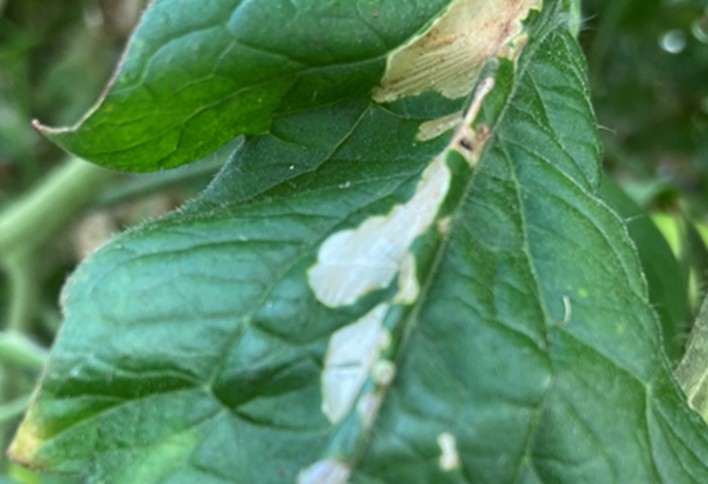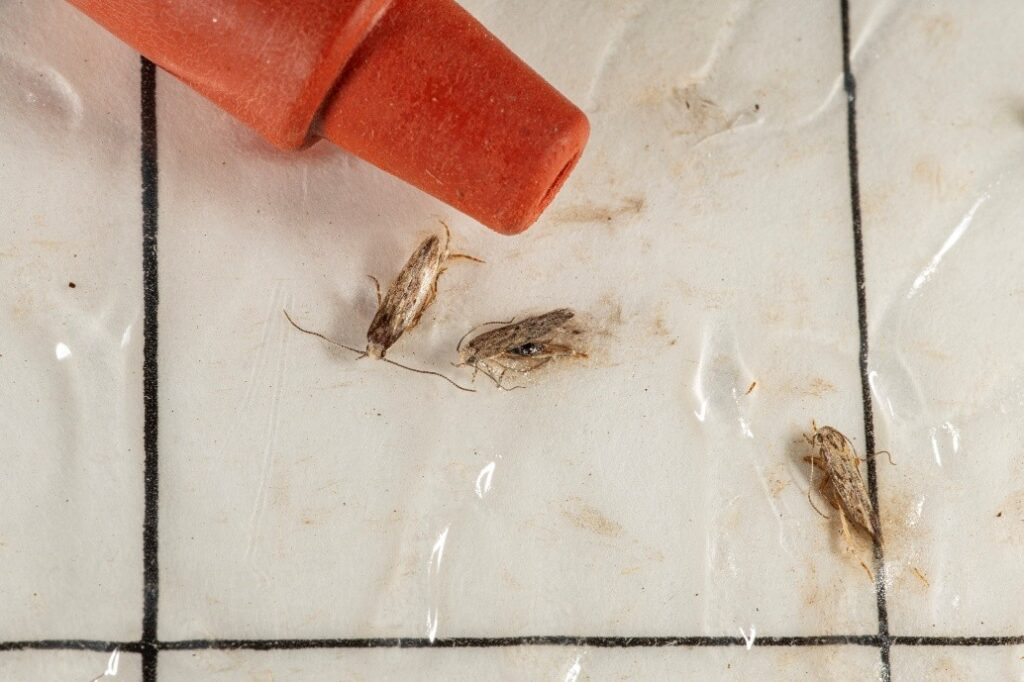If you are a high tunnel tomato grower, you may have encountered small, blotchy leaf mines (Figure 1) or tiny brown mottled moths (Figure 2) on your plants in the past few years. These tiny pests are the tomato pinworm, Keiferia lycopersicella (family Gelechiidae). They should not be confused with the leaf mining fly, Liromyza sativae, which creates narrow winding mines on the leaves of plants, including tomato. Their native range includes several warm states such as California, Hawaii, and Texas, as well as countries in Central America. They are occasionally found in temperate region greenhouses, often coming from infested stock plants. However, in recent years, they have made their way to Indiana and are widespread in high tunnel tomato production. Their presence and feeding cause anywhere from minor leaf damage to significant crop failure, depending on the severity of infestation. Although these moths prefer tomato plants, they are capable of feeding on any plants in the Solanaceae family. This can include potatoes, peppers, and eggplants, as well as several weeds in the nightshade family.
Tomato pinworms, much like other moths, undergo complete metamorphosis and cause most of their damage during their larval (caterpillar) stages. The larvae hatch from small, singular eggs laid on the underside of the leaf and burrow inside, eating between the outer layers of the plant and creating a small, blotchy mine. They feed in this manner for a week or two in their early instars, inflicting increasingly larger mines on the plants, until they then emerge to curl the leaf over (Figure 3) and continue protected feeding until pupation. After pupation, the adults emerge to mate and reproduce, not causing any damage. Their full life cycle typically takes upwards of a month to complete, and they go through about eight generations per year. Oftentimes, the moths experience overlapping generations, making them a more difficult pest to manage. In most situations we have encountered, pinworms do not cause significant fruit damage. In most situations, we have encountered damage that is restricted to the leaves and sometimes the stems, late in the season. This can indirectly reduce plant yield by lowering the plant’s photosynthesis capacity. In rare situations, we have seen severe populations spill over into the fruit and cause severe economic damage.
In terms of management tactics, common techniques for managing this pest include cultural practices and biological control tactics. Pheromone-baited sticky traps are available and can be used to monitor adult activity. If you find any blotchy mines or larvae in any leaves, prune and remove them as soon as possible. In terms of biological control, several species of parasitoid wasps in the Trichogramma genus are effective egg parasitoids and can be bought and released. We have not tested this in high tunnels. Additionally, there are some parasitoid wasps, including those in the Parahormius genus, that also appear to parasitize larval pinworms; however, little is currently known about their abundance and distribution in our region. We have recovered parasitoids from infestations in West Lafayette and are awaiting positive ID. Insecticides used for other tomato-feeding caterpillars, including foliar applications of Bt, can manage the larvae, but only during the transition from egg to larva and when they exit the mine before they curl back into the leaf protection. One novel method of pest management may include the tactic of mating disruption, which has been successfully used in orchards to manage codling moths. This would involve saturating the HT with the synthetic pheromone, making it nearly impossible for the adult moths to successfully find a mate in all of the ‘noise’ of pheromone from the lures. Please refer to the Midwest Vegetable Production Guide, specifically the section on caterpillar pests in tomatoes, for more detailed management solutions. When applying insecticides, remember to follow the label; it’s the law.


